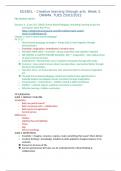ED1BCL – Creative learning through arts. Week 3.
DRAMA. TUES 25/01/2022
PRE SESSION NOTES:
Dawson, K., & Lee, B.K. (2018). Drama-Based Pedagogy: Activating Learning Across the
Curriculum. Short Run Press.
https://ebookcentral.proquest.com/lib/reading/reader.action?
docID=5316846&ppg=28
Chapter 2: what is drama based pedagogy?
PP 17-27
o Drama-based pedagogy strategies = brings body & mind together through
drama/theatre.
o Ensemble, imagination, embodiment, narrative story.
o MICHAEL ROHD 2002 = ensemble = group of ppl that work together regularly.
o LEE, ENCISO, & AUSTIN THEATRE ALLIANCE, 2017 = imagination = kids making sense
of what is in front of them.
o Embodiment = demonstrate real or imagined viewpoints through their body.
In drama = show what is known about concepts/ideas, represented better through
physical representation.
o Narrative story = in drama educator uses story/narrative to structure imaginative
act.
Through drama-based pedagogy, students & teachers have opportunity to
embody/explore/investigate/rewrite narratives through imagination.
o Consciousness = 2 dimensions – intellect (mind) & affect (emotions).
o Intellect = rational, logical, academic curriculum in classroom.
o Affective learning = hidden curriculum.
PP SLIDESHOW:
SLIDE 1: DRAMA V THEATRE
Similarities:
- Both use performance?
- Both use group work - collaboration
- Both express imagination?
- Central person
Differences:
- Clothes
- Lighting (focused lighting)
- Props
- Age
- Set/surroundings
SLIDE 2: DEFINITIONS
o Creativity = imagine, conceive, express, make something that wasn’t there before
o Creative thinking = knowledge, intuition & skills applied to imagine/express in its
contexts.
Present in all areas of life.
Can be spontaneous BUT also can be underpinned by critical thinking &
collaboration.
, ED1BCL – Creative learning through arts. Week 3.
DRAMA. TUES 25/01/2022
Teaching for creativity = using pedagogies & practices that cultivate creativity in
young ppl.
SLIDE 3: DRAMA
o Drama = symbolic lang where we represent the real world.
o Used in rituals to influence real world
o Many forms & languages of drama:
Masks
Music theatre
Highly stylised forms
Naturalistic life like forms
Puppets
Mime
Film
Drama in schools
SLIDE 16: ETYMOLOGY
o Drama =
Greek drama: action, deed: play, spectacle
Drāo: to do, make, act, perform
o Theatre =
Greek theatron: place for viewing
Theasthai: to behold
SLIDE 17: THEATRE
o BECKERMAN, 1979 = 1 or more humans isolated in time & space, present themselves
in imagined acts to others
o LOPE DE VEGA cited in BOAL, 1995 = theatre is 2 humans, a passion & a platform
o AUGUSTO BOAL, 1992 = theatre is art of looking at ourselves
theatre = stories
theatre’s roots = oral storytelling
o PETER BROOK = study animals go to zoo, study ppl go to theatre
o Memories only exist when we recreate them.
o They change & shift every time we think about them.
o They’re a story
SLIDE 19: DRAMA IN EDUCATION
o LAMBERT & O’NEIL = drama in ed is mode of learning… pupils can learn to explore
issues, events & relationships.
o WOOLLAND = drama is social are form…how ppl relate to world they live in & how
they interact with each other & society in wider sense.
o DOROTHY HEATHCOTE cited in Wagner, 1976 = difference between theatre &
classroom drama = in theatre everything is contrived so audience gets the kicks. In
classroom = participants get the kicks. BUT roots are same.
SLIDE 21: JONOTHAN NEELANDS
o Drama should be child-centred.
- what child already knows & introduces new through teacher intervention.
o Isn’t concerned with transmission of theatre-skills.
- Child experiencing rather than performing
o Practical, immediate & engages emotions & intellect.




